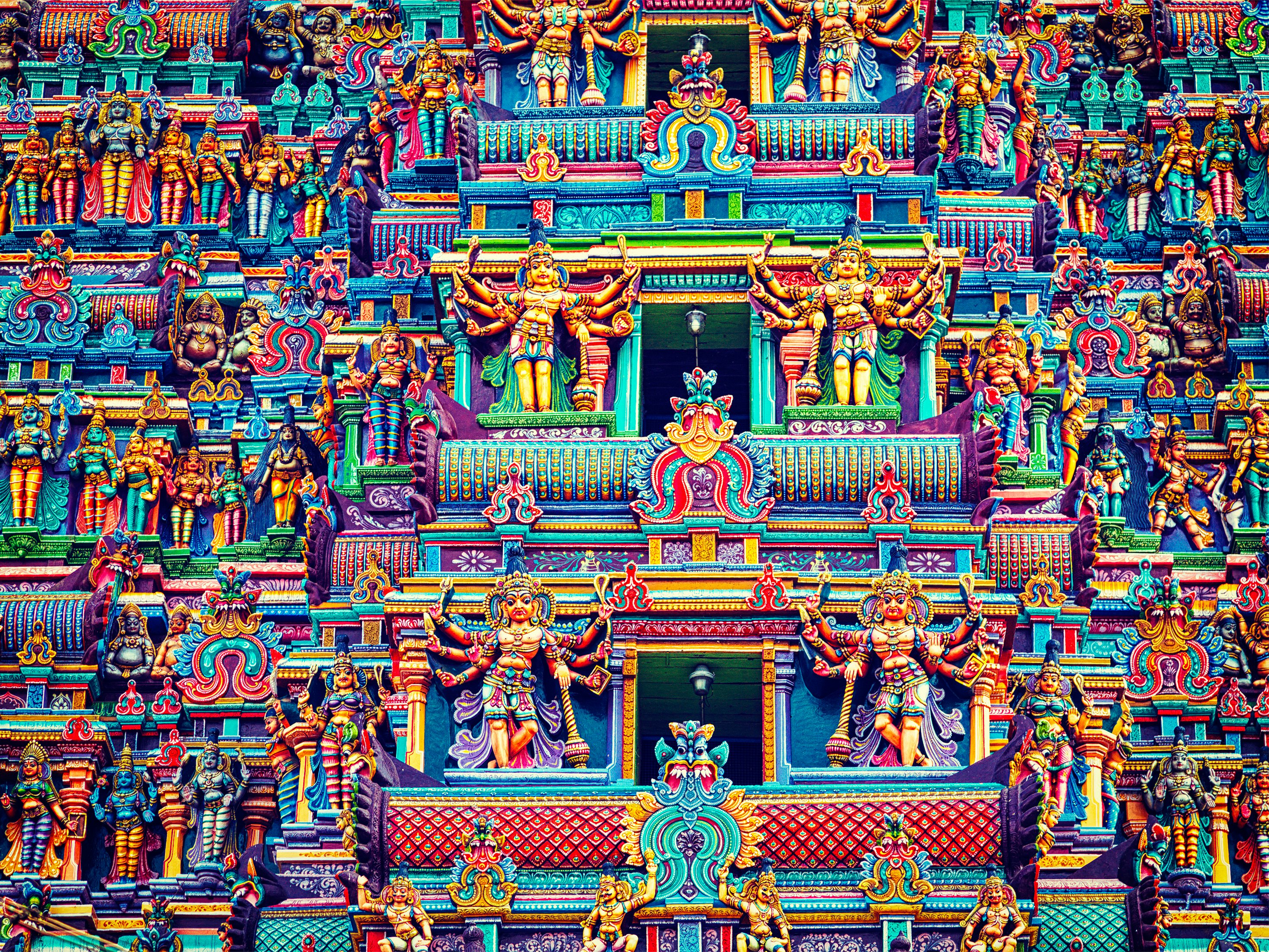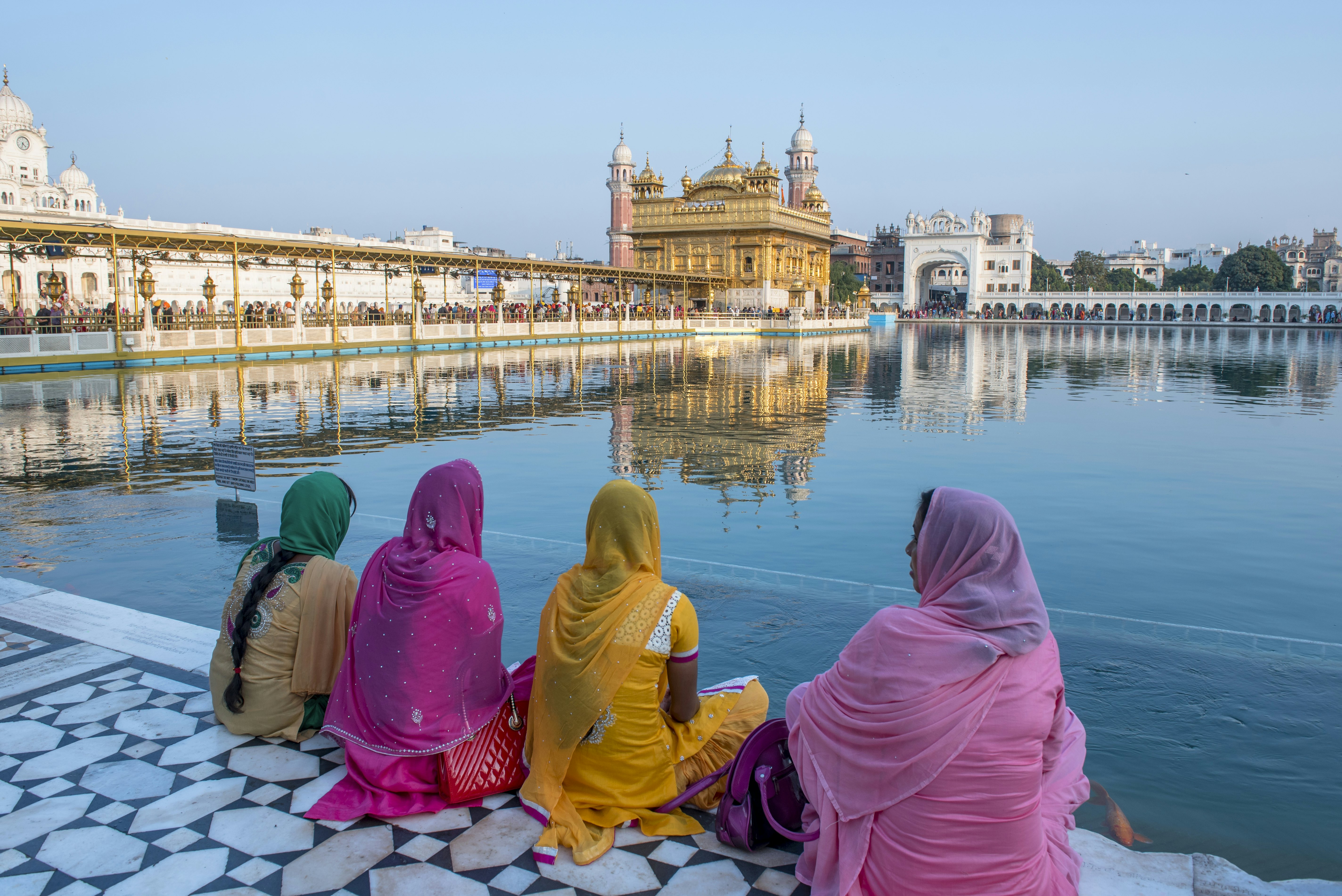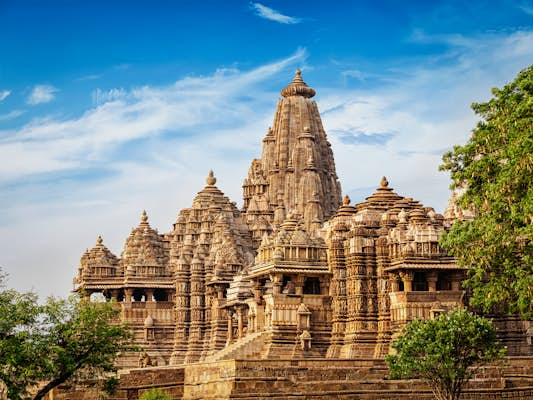India was the birthplace of four of the world’s great religions – Hinduism, Buddhism, Sikhism and Jainism – and a crucible for many more, from Islam and Christianity to Zoroastrianism and the Bahá’í Faith. Today, the country is home to the largest population of worshippers – and some of the most extravagant religious buildings – on the planet.
Visiting India’s temples, shrines, mosques and monasteries is one of the most captivating things to do in the subcontinent, particularly during religious festivals, when music, dance and colorful rituals push the atmosphere into overdrive.
While some sacred sites are historic ruins, many others are active places of worship, so visit respectfully. Some shrines can only be admired from the outside unless you are a follower of that particular faith. At others, you’ll have to remove your shoes, leave cameras, phones, food and leather items in lockers, and sometimes cover your legs, arms and head to enter.
Always check the rules before entering any sacred site. If you have to leave items outside or remove your footwear, there’ll normally be lockers, a cloakroom or a chappal (shoe) stand where you can deposit your belongings safely for a small fee.
Whether you are embarking on a spiritual journey or just love amazing architecture and culture, here are the top temples (and other sacred sites) to visit in India.

1. Marvel at Madurai’s Meenakshi Amman Temple
Best for vivid color
Advertisement
Hindu temples in India can broadly be divided into two major groups – the North Indian temples topped by shikhara spires, and the South Indian temples crowned by pyramid-like gopuram gateway towers. Some temples in the South India style almost qualify as skyscrapers, with gopurams reaching as high as 75m (246ft), adorned with depictions of Hindu deities, demons, mythical creatures and celestial beings.
A true marvel of South Indian architecture, the Meenakshi Amman Temple in Madurai is where the artistic meets the divine. This 17th-century complex was built during the Nayaks’ rule of Madurai, with 12 towering gopurams adorned with over a thousand statues depicting Hindu deities, demons and mythical figures.
The goddess Meenakshi (an incarnation of Parvati) is central to this sacred site and you’ll see her story expertly interwoven into carved scenes throughout the temple. Enter through the eastern gopuram and head straight to the Thousand Pillared Hall, which now houses the Temple Art Museum, full of bronze sculptures, paintings and a stunning green statue of Meenakshi Amman – a replica of the original hidden from sight in the temple’s Hindus-only inner sanctum.
Planning tip: Check out the set of musical pillars located to the west of the Thousand Pillared Hall – each pillar, when struck, is said to produce a different musical note.
2. Blush at the risqué carvings on the temples of Khajuraho, Madhya Pradesh
Best for elaborate temple carvings
Slightly isolated from other big sights in northern India, the city of Khajuraho in Madhya Pradesh is famed for its blush-inducing temple carvings. Nobody knew that sex sells better than the rulers of the ancient kingdom of Chandela, who slathered their temples with carvings of erotica between 950 and 1050 CE.
Khajuraho’s eyebrow-raising, UNESCO World Heritage–listed sanctuaries – especially the astounding temples of the Western Group – are some of the world’s finest examples of medieval religious art, featuring thousands of exquisitely detailed human figures, many involved in ambitious and athletic sexual activity.
The fenced-off Western Group of temples are Khajuraho’s most striking and best-preserved shrines. Highlights include the Varaha Shrine, with its intricately chiselled sandstone carving of Vishnu as his boar avatar, the Lakshmana Temple, whose orgiastic carvings include a nine-person orgy, and the refined – though no less risqué – Kandariya-Mahadeva Temple.
Detour: About 2½ hours west of Khajuraho, the tiny, off-the-tourist-trail town of Orchha is worth a side trip for its wildly romantic Rajput fortress, royal cenotaphs and temples.

3. Feel the powerful buzz of belief at Amritsar’s Golden Temple, Punjab
Best for atmosphere
The most important shrine for India’s 21 million Sikhs, the gleaming Golden Temple dominates the Punjab city of Amritsar, founded in 1573 by Guru Ram Das, the fourth of the 10 Sikh gurus. Thronged by pilgrims day and night, this revered gurdwara (Sikh place of worship) floats serenely in the middle of the Amrit Sarovar (Pool of Nectar), the sacred tank that gave the city its name.
The main entrance to the Golden Temple passes beneath an imposing clock tower that also houses the Central Sikh Museum, offering a mesmerizing first glimpse of the glittering, jewel-box-like main shrine, sitting at the end of a narrow causeway crammed with devotees.
Adorned with intricate marble inlay work and encased in golden panels, the shrine is topped by a dome gilded with 750kg of gold. In the inner sanctum (photography prohibited), priests chant hypnotically from the Guru Granth Sahib (the Sikh holy book) and a powerful sense of belief is tangible in the air.
Planning tip: To the southeast of the main compound is the Guru-Ka-Langar, an enormous dining hall serving round-the-clock free meals for devotees. If you partake, leave a donation to support the costs of this vast communal kitchen.
4. Follow in the footsteps of Akbar at Ajmer’s Khwaja Muin-ud-din Chisthi, Rajasthan
Best for cultural immersion
While temples and monasteries are the focus for Hindus, Jains and Buddhists, many followers of Sufism – a mystical form of Islam – worship at the tombs of Sufi saints. In the Rajasthani city of Ajmer, the dargah (tomb) of Khwaja Muin-ud-din Chishti is thronged at all hours by devotees, who gather here to pray, contemplate, sing devotional qawwali, study the Quran, and make offerings of flowers, scarves, incense and sandalwood at the saint’s gravesite.
Advertisement
Khwaja Muin-ud-din Chishti came to Ajmer from Persia in 1192 and died here in 1236, after a lifetime preaching a doctrine of tolerance, charity and compassion, earning him great respect from India’s Mughal rulers. Keen follower Akbar used to make the pilgrimage to this dargah every year from Agra.
Non-Muslim visitors are welcome, but respect is key. Remove your shoes, cover your head, leave your bag and camera in the cloakroom, and join the crowds of devotees, who will carry you forward like a living wave. Leaving a donation is also appropriate.
Planning tip: Ajmer is just a short bus ride from the sacred Hindu pilgrimage town of Pushkar. The town’s central lake is ring by ghats (sacred steps used for rituals), and there are several intriguing temples to visit, including one of India’s only surviving Brahma temples.

5. Swing by for morning prayers at Ladakh’s Thiksey Gompa, Ladakh
Best for tuning into spirituality
There’s no better way to get a feel for the monastic life central to Ladakh’s Buddhist culture than to attend morning prayers in one of the area’s ancient gompas (Tibetan Buddhist monasteries). One of the best-attended assemblies takes place every morning at the big, beautiful, 15th-century Thiksey Gompa, which cascades photogenically over a rocky hill about 18km from Leh.
The daily prayer meeting typically starts at 6am in summer (a little later in winter), lasting around two hours. The lamas’ deep-voiced chanting alternates with the simple reciting of mantras, moments of silence, bursts of clapping and thunderous trumpet blasts. You may even be offered a cup of salted butter tea by the novices.
Resembling a white-washed village from afar, Thiksey Gompa has 10 temples in all. The Maitreya Temple houses an exquisite, 12m-tall (39ft) golden Maitreya statue, created between 1977 and 1980, with an embedded conch shell serving as its third eye. Follow signs to the rooftop Lamo-Khang – the shrines up here are normally locked, but the views are wonderful.
Planning tip: A convenient detour on a trip to Thiksey is the old
Ladakhi capital of Shey. Its recently restored palace is mostly empty
but there’s a 17th-century temple with a colossal 8m-high (26ft) statue
of Sakyamuni, the historical Buddha. You can walk on up the ridge to
11th-century castle ruins for fine views.
6. Marvel at the carving-covered Sun Temple in Konark, Odisha
Best for symbolism
A UNESCO World Heritage site, the Sun Temple at Konark is one of India’s finest ancient monuments, and the most famous symbol of the state of Odisha. Raised in the 13th century, the main shrine here takes the form of an enormous stone chariot, honoring Surya, the Hindu sun god.
Start your explorations at the Konark Archaeological Museum to the north of the temple, displaying larger-than-life statues of nymphs and erotic carvings of couples, an excellent leogryph (half lion, half griffin), and several statues of Surya – identifiable by the lotus flowers that bloom in his light.
Follow the road clockwise to the Sun Temple’s eastern entrance gate and a dancing platform guarded by two stone lions (a Hindu symbol) standing atop crumpled elephants (a symbol of the Buddhist faith that flourished in Odisha before the revival of Hinduism). Work your way around to the 38m-high (125ft) Jagamohana (Assembly Hall), whose eastern door welcomes in dawn’s first sunlight.
Planning tip: Just down the road in Puri, the revered Jagannath Mandir is the focus for one of India’s most famous festivals. Honoring Vishnu as Jagannath, the Lord of the Universe, the Rath Yatra festival in June or July attracts vast crowds of devotees, who haul huge chariots bearing the temple deities through the streets. The festival was the origin of the word “juggernaut.”

7. The Temples of Hampi, Karnataka
Best for a sense of past grandeur
Dominated by the remains of the great Hindu city of Vijayanagar – home to half a million people before it was vanquished by the Deccan sultanates in the 16th century – Hampi is a truly magical place, as noteworthy for its powerful atmosphere and air of antiquity as for the exquisitely carved temple ruins that stud the boulder-studded plain flanking the Tungabhadra River.
Start exploring this cornucopia of ancient temples in the village of Hampi Bazaar, close to the railway junction town of Hosapete. Here, the towering South Indian-style Virupaksha Temple has been in use since the 7th century. Guides can show you to the upper levels for views of, and from, the magnificent 11-tier gopuram. Follow the street lined with stone pavilions – Vijayanagar’s original bazaar – to reach more temple ruins sprawling across the landscape.
Rising to the south of the Virupaksha Temple, the smooth granite slopes of Hemakuta Hill are scattered with more than 30 shrines and temples. It’s a popular place to watch the sunset but watch out for aggressive monkeys. Other must-see temples here include the Achyutaraya Temple, with its finely carved pillars, and the elegant Vittala Temple, with its intricate pavilions and chariot-shaped shrine to Garuda, Vishnu’s man-bird vahana (mount).
Detour: A few hours northwest from Hosapete by train, Badami is enclosed by rugged cliffs pock-marked with cave temples overlooking a 5th-century tank. There are more fine temples about 2½ hours west of Hosapete at Huballi, with intricate and detailed carvings created in the 11th century.
8. Be wowed by the carvings and murals at Ajanta and Ellora
Best for ancient history
Around 100km (62 miles) north of Aurangabad, 29 ancient manmade caverns line a verdant horseshoe-shaped river bend at Ajanta. The caves house ancient Buddhist viharas (temples) and chaityas (stupas) hewn from the bedrock between 200 BCE and 500 CE, making them some of the earliest religious buildings in India. It’s the intricate murals that draw people here, though, offering a window back onto Indian culture, faith and fashion almost two millennia ago.
About 29km (18 miles) northwest of Aurangabad, the caves and temples of Ellora showcase a different side to the area’s ancient artistry. This sprawling complex of caves and temples cut into – and out of – the dark basalt rock of the hillside includes some of India’s finest religious architecture, including the dramatic Kailash (Kailasa) Temple, the biggest monolithic sculpture in the world, covered in intricately carved deities.

9. Pay your respects at the Jama Masjid in Delhi
Best for visionary architecture
Not all of India’s magnificent Mughal mosques are open to non-Muslims, but the Jama Masjid, tucked into the tangled bazaars of Shahjahanabad (Old Delhi), is a wonderful exception. This dramatically striped marble and red-sandstone structure was Shah Jahan’s final architectural triumph, built between 1644 and 1658, and it can hold a mind-blowing 25,000 people.
Two tapered minarets rise to 40m (131ft), and one can be climbed for amazing views over the rooftops of Old Delhi and skies dotted with fluttering kites and birds of prey. From the top of the minaret, you can see how British colonial architect Edwin Lutyens incorporated the mosque into his design for New Delhi – the Jama Masjid, Connaught Place and Samvidhan Sadan (the former parliament house) are in a direct line.
Planning tip: Visitors should dress conservatively (covering legs and upper arms) and remove their shoes before entering the mosque (women should also cover their heads). The mosque is closed to tourists from noon to 1:30pm for prayers.
10. Seek enlightenment at the Mahabodhi Temple, Bodhgaya, Bihar
Best for a step back in time
Marking the spot where the historical Buddha, Siddhartha Gautama, attained enlightenment under a bodhi (fig) tree, the Mahabodhi Temple is the sacred heart of Bodhgaya, overflowing with women in brilliant saris, monks in maroon, orange or grey robes, and pious tourists from across the Buddhist world.
Visible above the exterior walls, the 50m-tall (164ft) carved stone tower of this 6th-century, UNESCO-listed Mahabodhi Temple calls like a beacon to the faithful. In the cooler months, almost every flat space in the compound is full of devotees reciting mantras, including in the shade of the Mahabodhi tree, a genetic descendant of the original fig tree beneath which the Buddha first grasped the Middle Way.
Around the temple are dozens of temples and monasteries staffed by Buddhist monks from across the globe, where
pilgrims study Buddhist scripture and practice meditation, many running
drop-in sessions or residential courses for those new to the faith.
Planning tip: The most accessible meditation center for international visitors is the soothingly peaceful Root Institute for Wisdom Culture, a spacious garden campus that’s affiliated with the worldwide FPMT (Foundation for the Preservation of Mahayana Tradition).

11. Marvel at the carvings on the Delwara Temples, Mt Abu, Rajasthan
Best for intricate details
Even by the extravagant standards of Jain architecture, the 11th-century Delwara Temples, 3km (1.9 miles) north of Mt Abu in Rajasthan, are something else – a recreation of the heavens on earth in milky marble. Arches overflow with writhing celestial beings and ceilings feature multi-armed deities wielding weapons and mandala-like roof bosses that bring to mind fractal patterns and passion-fruit flowers.
The older of the two temples is Vimal Vasahi, founded in 1031 CE by Vimal Shah, a minister from the Chaulukya kingdom in Gujarat. Dedicated to the Jain teacher Rishabhadeva (Adinath), it took 1500 masons and 1200 labourers 14 years to build, at a cost of 185.3 million rupees. Adjacent, the flamboyantly carved Luna Vasahi Temple is dedicated to Neminath, the 22nd tirthankar (Jain teacher); it was constructed in 1230, for a more modest 125.3 million rupees.
Detour: There are more magnificent Jain temples in Ranakpur near Udaipur and the Rajasthani city of Jaisalmer, tucked into the knotted alleyways of the golden-hued Jaisalmer Fort. At almost all of the state’s Jain temples, leather articles, food, cameras and phones must be left at the entrance, and menstruating women are asked not to enter.
This article was adapted from Lonely Planet’s India guidebook, published in November 2024.

